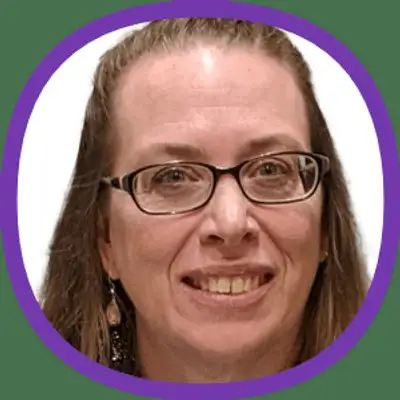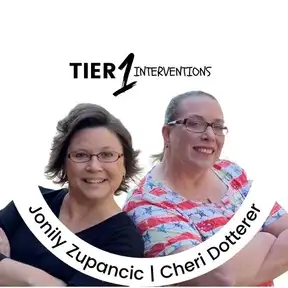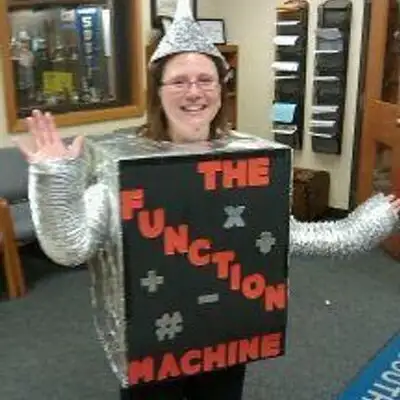
Miracle Math Classroom: T1I S1 E1
Jonily : That's the point of
tier one intervention is to
create this environment,
inclusive and accessible to all,
but not stripping the complexity
out of the mathematics.
Cheri Dotterer: Hello, everyone.
I'm Cheri Dotterer. And I'm here
with Jonily Zupancic. And we are
here at tier one interventions.
And we are so glad to have you
here today. Lee, we
Jonily : have a good bit of
content today that we're going
to roll out to you. We're gonna
lay some foundation, though, and
define what is tier one
intervention. And we're going to
start by Sheree and I are going
to converse a little bit about
that crazy C word that seems
like it keeps coming back. And
that is COVID. And I don't know
if it's a good or a bad thing
that we're starting with that
conversation. But I think it's
necessary. I believe that it
keeps coming back even years
later, because I believe that it
is an effect that has been on
humans since 2020. And it's
drastically changed our
emotions, our mindsets, our
practices, our thinking. And the
first thing that I want to say
about COVID in its relation to
tier one interventions is tier
one being whole class general
classroom instruction, meaning
for the last probably dozen
years or so we've moved more to
inclusion model in schools,
which means mainstream we want
every kid regardless of ability,
deficit struggle, we want them
to experience whole classroom
regular general instruction,
which we're going to call tier
one. Tier one is whole classroom
regular classroom. And I will
say that prior to COVID. In math
and writing, tier one was not
where it should be, regardless
of COVID. I actually got a
little excited post COVID
Because I thought this is a
chance to reframe what regular
classroom tier one looks like
feels sounds. And now we can
move forward with growth on
serving all kids in this tier
one inclusion model. But my fear
has come to be and that is we've
regressed back to where we were
prior to COVID. And I think that
in many classrooms, we've
defaulted back to even pre
COVID, where it was not
instruction for inclusion at
all. It is time today and for
all of the sessions to have
these conversations. That was a
lot share, you asked me to share
a little bit, but that was a
lot. And I know that you have
some specifics for writing. But
Sherry, let's just talk you and
I a little bit about how COVID
has affected schools, students,
and especially our students with
learning specialties.
Cheri Dotterer: Sure. As I was
contemplating and thinking about
the impact of COVID on my
students and job in general, one
thing I reflected back on as an
OT might, generally, across the
country and even in other parts
of the world. OT caseload, were
escalating even before COVID, we
were hearing conversations of
OTS having 100 kids on their
caseload, and I'm like, How do
you do that and treat the child
with efficiency and meet the
goals the way they're supposed
to be met? Because it's
impossible to see 100 kids as an
OT, and to do sessions with them
that are go small groups. We see
a lot of kids more in the tier
three, which we'll talk about in
a little bit. But that's more
like a one on one session. We
generally can do like a two on
one. But Medicaid doesn't allow
us to do bigger groups. Unless
we adjust time like there's so a
lot of rules about the way we
are allowed to treat kids and I
I know. So I worked in cyber,
before COVID head. So cyber had
its own issues. I know my kids
went to cyber. So I know that
there was 165 kids in a English
class general ninth grade
English for one of my kids, and
I can't remember, I think it was
Michael's class. And I'm like,
for the teacher. That's a lot of
work to be greeting Romeo and
Juliet 165 times. But yet, you
break that down, there is no
feasible way that a physically
and OT could work one on one
with a kid because a lot of what
I was doing, even in the world
of cyber, I was going to their
home, which is where they went
to school. And I was doing
direct treatment, I'm physically
in a home for one hour, one on
one with a kiddo with the travel
time with plus travel time, and
typically there was an hour
between kids. So just that's the
way that's the nature of being
in home health, home environment
setting, even when I worked in
home health, with adult rehab.
So there were some times I was
traveling two hours between
clients. So I say that, and yes,
I did work in a brick and mortar
building as well. And I was
maxed out, my brain was maxed
out trying to manage 15. Now, I
know Teresa is on this call, she
has a caseload nearly 100 kids
that she's trying to manage. But
the difference between that kind
of her caseload, and sometimes
what I was referring to, was
that she is the OT she has an an
occupational therapy assistant,
supporting her with some of the
students. So that's a code is
doing some of the work as a math
teacher, you don't get a math
assistant teacher helping you
out. But there, the way the
structure is, with ot two,
teaching is a little bit
different. So when I heard these
case loads going on, I'm like,
how can we change? How can we
make it so that it's reusable?
And that's when I'm started
delving into what can we do in a
kindergarten classroom, to
collaborate, co teach, and
potentially, upfront our
intervention, so that we can
help cover these kids that are
going to struggle potentially
later, by giving them intensive
instruction. And when I go to
all of the research on the
science of reading, that's
exactly what structured literacy
is designed to do is to create
intensive reading instruction,
so that down the road, we can
decrease the number of tier two
and tier three.
Jonily : And obviously, tier two
and tier three are never going
to be eliminated. No, but as you
talked about Sherry, prior to
COVID, not only our occupational
therapists caseload is
increasing. But the number of
kids with math needs were
increasing, then COVID hits, and
then we're out of control with
the number of kids that have
needs. So either the kids have
to change, or we have to change.
And what Sherry and I are
promoting is that we in schools
in tier one regular classroom,
make changes, so that the bottom
line is, we are able to serve
more kids in less time with more
frequency, and not eliminate,
but reduce the number of
students for needs at the tier
two tier three level. And we'll
define these tiers in a moment
more specifically, but right
now, I just want Sherry And I'd
have this conversation that I
want everybody listening to just
hear the conversation as a
thought provoking exercise. So
the point of Tier one is to be
able to serve more kids in less
time through this collaborative
process. Let me talk about what
I do what Cheri does, I am
Cheri Dotterer: rupt you for a
moment. Yeah, go ahead. And what
struck me about math class is I
had this experience One day, and
it hit me like led brick. I was
actually while while I was
writing, handwriting Brain Body
disconnect, I was substitute
teaching. And I was I took a job
in a learning support classroom.
So I was the Learning Support
teacher for the day. One of the
students, I had to shadow them
into math class. And I had
already known you or I was just
getting to know you at that we
Jonily : know math classes
broken Cherie, so just lay it on
us here. But
Cheri Dotterer: so that was
like, 2018 ish, that this
happen. And I'm going, Whoa, I
can see where this kid is
struggling. Now. He was in a pre
algebra class. So he was in
ninth grade, which was not my
typical, I usually was taking
elementary kids when I was doing
the substitute teaching. But
they had asked me they were
like, I need some support today.
So I took the job. And I ended
up doing a lot of OT for not
just that kid in the class, but
several other the other kids in
that class. And the teacher
went, where did you come from,
and, and had no idea where I was
trying to intervene and not stop
the math class. But yet, I
needed to because he was going a
mile a minute. And I think this
is one of those scenarios that
we talked about in math
disconnected. And for anybody
who is listening, I know that
might take us off on a tangent.
But when I think it was one of
those things that we were
talking about, as we were
developing that story, where the
math teacher gets derailed by
the therapist, because the
therapist is coming in making
suggestions on how to change the
entire classroom to make it more
accessible for all students
boom.
Jonily : Absolutely. That's of
tier one intervention is to
create this environment,
inclusive and accessible to all,
but not stripping the complexity
out of the mathematics. And what
we're going to bring to you
today. Through tier one
instruction. Tier one
intervention is how to increase
the complexity of the
mathematics. So we're going to
actually have our most
struggling kids learning more
understanding more, and being
able to decipher more math,
symbols and notations that are
their biggest struggle. We're
going to increase the complexity
for all but we're also going to
increase the accessibility at
the same time too good to be
true. It's not that's what we're
bringing to you today. And that
is exactly what's your one means
with Sherry, being occupational
therapist, from this medical
world, from this neuroscience
world, from this brain based
world, and myself Jonily Being
from the educational world,
general classroom teacher, as we
begin to have these
conversations, and then we've
had these conversations over
time, we realize that what we're
doing in our own worlds without
the connection of each other, is
not serving these kids long
term. So through our
collaboration, and through
Sherry's therapies, and math
interventions together, what we
bring to you is the post COVID
Miracle math classroom, for lack
of a better phrasing. And I know
Sherry, you talked you always
are talking to me about the
execution of writing, the fall
of writing. Sheree, talk to us a
little bit about how in 2009,
like way prior to COVID, the
effects that legislation had on
writing in the classroom. And
I'll make that connection to the
mathematics. And I know it
sounds like oh, my gosh, in this
first 30 minutes, we're just
we're like, massaging the
problem, but it's the elephant
in the room. We've got to talk
about these things. And then for
the following two hours, it's
going to be all solution based.
But Sherry talked about some of
the catastrophe that happened
with writing, and explicit
writing instruction or lack
thereof. And then I'll parallel
that to mathematics. And why
this is affected tier one
instruction as well.
Cheri Dotterer: My entire career
has been funding changes so on
But I'm even going to take it
back a little step further
because yeah, graduated from
college in the late 90s, I
entered acute care. As they were
changing all the fundings and
all the regulations from you
could treat kit people as long
as you want. And that's when
they were trying to minimize the
amount of time that you spend in
the hospital. So we went from
this large gap of time spent in
a hospital enter acute care, we
start DRGs. So don't worry about
what the definitions is with
those. But they were trying to
shorten hospital stay. I moved
my progress my life over to long
term care. The whole medical
world shifted. And now they were
implementing the same DRGs and
in subacute, an acute and long
term care. So I work with that a
while. By the time I get to
homecare, they did the same
thing with DRGs and have gone,
when am I going to get free of
this limiting my ability to do
work, I transitioned over to
pediatrics. And doggone it,
don't they come up with a thing
called Common Core. So around
the time that I was starting to
work in pediatric school based
therapy, I was also working
early intervention zero to two.
So I was going out to homes and
I'm working with babies,
toddlers, don't they do the same
art thing where they have
similar things called the same
DRGs, which were the limiting
the thing to babies and
toddlers, which happened around
2009. And what happened was,
when babies were having a Dilek
developmental delay, they will
come out and there were six
domains. And don't ask me to
recall those domains, right at
the moment, because I forgot to
pull that up and list them out
because I can never remember
them. Anyway, long term short
is, within those six domains, if
there was one of them that there
was 25% delay, they could get
therapy for that area. So it
could have been that they needed
learning support. So they get an
actual special education teacher
who was zero to two trained. So
I don't know where you get that
specific training in education,
I think you have to go back and
get a master's degree. But
besides birth one, so you could
get that if they had gross motor
skills, they were getting PT,
speech, delay, speech, therapy,
and then ot would do fine motor
and play. While that was
happening, I was also working
school system. And we were doing
pretty good. And NAD around word
2012, this thing called Common
Core hit and I'm like, What is
going on. And that's when the
escalation started. So the
combination of oxtails sub the
kids hitting first second grade
having that decrease in that
percentage, because so I forgot
to say was that with the change
in Rockdale, it was now overall
25%. So it wasn't just one area,
it was overall 25%. So you could
have still had it 30% delay in
fine motor skills and knockout
therapy. So now these kids we're
hitting kindergarten, first
grade, I'm working with these
kids, and I'm getting more
referrals for for kindergarten
and first grade, that they're
struggling with fine motor
skills, incomes Common Core. And
we get escalated. And all of a
sudden, caseloads are starting
to go Raizy across the board in
occupational therapy, and we're
like, What in the world is
happening as
Jonily : far as fine motor
handwriting, those types of
things. And because it was not
direct in the curriculum
anymore.
Cheri Dotterer: And so thank you
for referring my brain back to
what happened in Common Core is
the writing standards do not
specifically say handwriting
instruction. They say text and
font. And the way it's worded it
does not say that somebody needs
to be able to read and write in
a handwritten font. All of a
sudden, all these other demands
were coming on the teachers
Himani get pushed and pushed and
pushed. And all of a sudden
there's just no time in the day
to do that. recommended 20
minutes of handwriting
instruction, which is what the
research says. The research says
20 minutes of handwriting
practice per day improves long
term handwriting it also
improves memory and retention
skills. Boom, let's
Jonily : not just like breeze by
that. It also improves memory
and retention skills.
Unknown: Nilima says tier one
interventions was a sensitizing
workshop systematically thought
through put into an easy to
understand framework and well
presented. Thank you to you
both. Thank you Nilima. You've
been listening to tier one
interventions with Jonily
Zupancic and Cheri daughter.
Tier one interventions is
released on the first and third
Tuesday of the month. The
podcast is recorded live on the
third Saturday of each month
except July, the first segment
of the podcast is released to
your favorite podcast app. To
hear the entire workshop go to
tier one interventions.com and
register for our mailing list to
get all the news about the next
episode. Be sure to subscribe so
you don't miss the next episodes
release. Do us a favor give us a
five star rating and write a
review. Every vote matters. I'm
Nicholas King, an intern for
cheri Dotterer educational
consulting
Episode Video
Creators and Guests


